Our Summary
This study looked at changes in lung-related symptoms in people who have had their larynx removed (laryngectomy) and use a device called a heat and moisture exchanger (HME) to help them breathe. The researchers introduced a new version of the HME and tested it in two phases. In the first phase, 42 individuals switched from their current HME to the new one. In the second phase, the participants used the full range of new HMEs to find the best one for them. They measured changes in symptoms, device usage, sleep, skin health, quality of life, and satisfaction. They found that using the new HMEs resulted in significant improvements in coughing symptoms, mucus symptoms, reasons for changing the device, uncontrollable coughs, and sleep. The results suggest that the new HME devices are beneficial and lead to improved symptoms for individuals post-laryngectomy.
FAQs
- What were the significant improvements observed in patients using the new HME devices post-laryngectomy?
- How were the effectiveness of the new HME devices determined in the study?
- Did the use of the new HME devices post-laryngectomy lead to improved sleep and skin health?
Doctor’s Tip
A doctor might advise a patient who has had a laryngectomy to consider using a heat and moisture exchanger (HME) to help with breathing and improve symptoms such as coughing and mucus. It may be helpful to try different types of HME devices to find the one that works best for you and leads to improved quality of life.
Suitable For
Patients who have undergone laryngectomy surgery are typically recommended to use a heat and moisture exchanger (HME) device to help them breathe. This study specifically looked at individuals who have had their larynx removed and use an HME. These patients may experience symptoms such as coughing, mucus production, uncontrollable coughs, and sleep disturbances. The use of a new HME device was found to significantly improve these symptoms and lead to overall better quality of life for individuals post-laryngectomy.
Timeline
Before laryngectomy:
- Patient may experience symptoms such as difficulty breathing, coughing, hoarseness, or a feeling of something stuck in the throat
- Patient is diagnosed with a condition that requires laryngectomy, such as cancer of the larynx
- Patient undergoes surgery to remove the larynx
- Patient may undergo radiation therapy or chemotherapy as part of their treatment plan
After laryngectomy:
- Patient may experience difficulty speaking and swallowing due to the absence of the larynx
- Patient may need to learn new ways of speaking, such as using a speech prosthesis or an electrolarynx
- Patient may experience changes in their breathing patterns and may need to use a device such as an HME to help them breathe more comfortably
- Patient may experience changes in their quality of life and overall satisfaction with their treatment and recovery process
What to Ask Your Doctor
What is a laryngectomy and why is it necessary for me?
How will the laryngectomy affect my ability to speak and breathe?
What are the potential complications or risks associated with a laryngectomy?
How will my quality of life be impacted after the laryngectomy?
What is a heat and moisture exchanger (HME) and how can it help me after my laryngectomy?
How do I properly use and care for the HME device?
What are the potential side effects or issues I may experience while using the HME device?
How often should I replace the HME device?
Are there any lifestyle changes or adjustments I should make after the laryngectomy and while using the HME device?
How often should I follow up with you or a healthcare provider to monitor my progress and address any concerns?
Reference
Authors: Ward EC, Hancock K, Boxall J, Burns CL, Spurgin AL, Lehn B, Hoey J, Robinson R, Coleman A. Journal: Head Neck. 2023 Apr;45(4):939-951. doi: 10.1002/hed.27323. Epub 2023 Feb 20. PMID: 36808179
